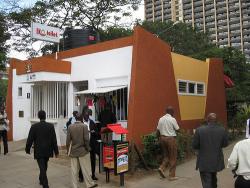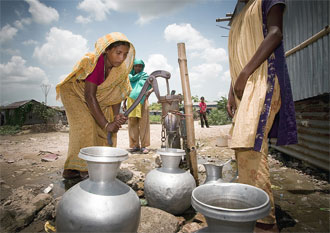 WASHINGTON, Mar 2 (OneWorld.net) – Three local social entrepreneurs have come up with creative — and lucrative — solutions to poor sanitation in their communities in Africa, where six out of ten people do not have access to a sanitary toilet.
WASHINGTON, Mar 2 (OneWorld.net) – Three local social entrepreneurs have come up with creative — and lucrative — solutions to poor sanitation in their communities in Africa, where six out of ten people do not have access to a sanitary toilet.
Social entrepreneur David Kuria’s Ecotact “toilet malls” in Nairobi, Kenya “toilet malls” provide bathroom facilities along with shoe shines, food, phone booths, and other commercial services. © Water, Sanitation, and Hygiene Photos (flickr) David Kuria’s “toilet malls” are attracting tens of thousands of customers each day in Nairobi’s densely populated Kibera neighborhood. Trevor Mulaudzi employs hundreds of South Africans in a public-toilet clean up enterprise, while Nigerian Dr. Joseph Adelegan is turning animal waste into cooking fuel for the urban poor in Africa’s most populous nation. (See the full article below.)
Providing low-income people with access to clean water is one of the most important issues facing developing countries worldwide. Studies show that sanitation projects deliver highly impressive economic returns of $9 for each $1 of investment, primarily by lowering health care costs and allowing for more regular school and work attendance.
Since the early 1990s, 1 billion people have gained access to clean water worldwide thanks to government initiatives and nongovernmental projects. Nonetheless, 18 percent of the world’s population — including half of the population of South Asia — continues to suffer the indignity of open defecation, mostly in rural areas. Global access to safe sanitation increased only from 54 percent to 62 percent between 1990 and 2006, leaving 2.5 billion people without access.
From: Water Advocates
February 26, 2009 (Washington, D.C.)- Human excrement is serious business. Three African social entrepreneurs, David Kuria, Joseph Adelegan and Trevor Mulaudzi, spoke at the National Press Club last week to share this revolutionary approach to solving the global sanitation crisis. The entrepreneurs speak from experience; each has established lucrative and groundbreaking businesses related to people “doing their business.” Their business models, once considered distractions in the traditional policy or charity realm, are proving to be successful ventures. Their innovations are successfully shifting social behavior and improving public health, the environment and the economy. Trevor Mulaudzi, a South African entrepreneur, stressed that “no one wants to use a dirty toilet no matter how poor they are.”
Entrepreneur David Kuria is making the toilet a hot commodity in Kibera, one of the largest slums in Kenya. To increase demand for and maintenance of toilets in the slums, he founded a venture called Ecotact. “Why just do two quick things in the toilet?” Kuria asks. Ecotact builds “toilet malls” that provide bathroom facilities along with shoe shines, food, phone booths and other commercial services. Each toilet complex is equipped with 8 toilets, a water kiosk, a baby changing station and gender separate showers. 30,000 customers use Ecotact’s facilities every day. Corporations now vie for advertising, while the nearby vendors strive to keep the toilets clean. And it is the business model, not charity or education alone, that drives this success.
Lately the toilet malls have been attracting unlikely champions – a popular comedian who does a stand-up sketch about toilets, the country’s beauty queen, Miss Kenya, and the nation’s Vice President himself, who recently stopped in to use the facilities and pose for photos. In a continent where more than six out of every ten people do not have a sanitary toilet, this new service is removing the taboo around human waste, creating jobs, improving self esteem and making communities enthusiastic about hygiene.
Kuria has recently won several international awards for his work. He is collaborating with Ashoka, Rotary, the Global Water Challenge, the Acumen Fund and other social entrepreneurs internationally to scale up his model and combine it with similar innovations. There is promise for it to extend throughout Kenya and the rest of Africa.
For Nigerian entrepreneur Dr. Joseph Adelegan, a civil engineer by training, human and animal waste was not waste but an opportunity that should not be wasted. A nearby slaughterhouse had been disposing daily the waste of 1,000 slaughtered cows directly into a local river. Joseph designed a bioreactor that digests the waste into biogas that generates electricity and is used for cooking fuel. Local women’s organizations sell the fuel at affordable prices for urban poor. The solid waste left over is a cheap and effective fertilizer. His models, named “Cows to Kilowatts” and “Power to the Poor,” also reduce emission of methane gas, a potent greenhouse gas. His initiative has also improved the quality of the water that the local community uses for cleaning and bathing.
Adelegan’s successful business model not only tackles the technological aspects of this problem, but – even more powerfully – it has mobilized the community. It has even stirred the Nigerian government, which used to block such initiatives, into action. In 2008, his model was accepted into national policy and will be replicated within other slaughterhouses in Nigeria. Meanwhile, Dr. Adelegan, has also been featured on CNN, awarded prizes from the World Economic Forum and covered recently in Fortune magazine. He is now working with other social entrepreneurs to extend the approach to other African countries.
Trevor Mulaudzi, a South African entrepreneur, applies many of these same principles in his business, The Clean Shop. A clean toilet is good business for The Clean Shop. It offers schools and large organizations sanitation services, such as cleaning toilets and repairing plumbing in schools, teaching students hygiene lessons.
A mining geologist by training, Mulaudzi recalled how he set out on this career path the very day he found children skipping class and defecating in the open because their school’s toilet was piled with feces. Now, The Clean Shop employees three hundred people who move in and clean up unusable toilet facilities. They turn them into attractive and dignified places, sometimes with no initial payment or contract.
Mulaudzi approaches the sanitation problem from the perspective of an educator rather than a cleaning contractor. He has used such motivational techniques as requiring that each student bring his or her own roll of toilet paper as the “admission ticket” to the shiny new restroom. In doing so, he builds a sense of pride, dignity and responsibility. It usually evolves into toilet-user demand for clean toilets, which ripples up to change administrative and even government policy. Students in one location even held a protest when Mulaudzi’s contract was not renewed; it prompted the administration to reverse their decision.
Trevor Mulaudzi is a finalist in the Ashoka Changemaker’s recent global competition for innovative solutions to water and sanitation problems. In addition, Trevor has recently been hosted by the government of Malaysia to discuss transferring the lessons of this model.
These three leading entrepreneurs have been working with other entrepreneurs in Africa to establish a new vision of water and waste management where clean water and facilities inspire public pride which translates to political influence, and where waste management and sanitation deliver public health and environmental benefits through an economically profitable business model.
“It can’t be business as usual-real impact needs a new approach that integrates together different approaches to resolving the water and sanitation crisis,” concludes Joseph Adelegan.





